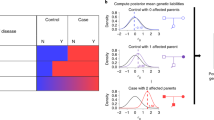Abstract
Selection of cases with additional affected relatives has been shown to increase the power of the case-control association design. We investigated whether this strategy can also improve the power of family-based association studies that use the transmission disequilibrium test (TDT), while accounting for the effects of residual polygenic and environmental factors on disease liability. Ascertainment of parent-offspring trios conditional on the proband having affected first-degree relatives almost always reduced the power of the TDT. For many disease models, this reduction was quite considerable. In contrast, for the same sample size, designs that analyzed more than one affected offspring per family often improved power when compared to the standard parent-offspring trio design. Together, our results suggest that (1) residual polygenic and environmental influences should be considered when estimating the power of the TDT for studies that ascertain families with multiple affected relatives; (2) if trios are selected conditional on having additional affected offspring, then it is important to genotype and include in the analysis the additional siblings; (3) the ascertainment strategy should be considered when interpreting results from TDT analyses. Our analytic approach to estimate the asymptotic power of the TDT is implemented online at http://pngu.mgh.harvard.edu/∼purcell/gpc/.


Similar content being viewed by others
References
Abecasis GR, Cardon LR, Cookson WO (2000) A general test of association for quantitative traits in nuclear families. Am J Hum Genet 66:279–292
Antoniou AC, Easton DF (2003) Polygenic inheritance of breast cancer: implications for design of association studies. Genet Epidemiol 25:190–202
Chen WM, Deng HW (2001) A general and accurate approach for computing the statistical power of the transmission disequilibrium test for complex disease genes. Genet Epidemiol 21:53–67
Falconer DS (1981) Introduction to quantitative genetics. Longman, New York
Fulker DW, Cherny SS, Sham PC, Hewitt JK (1999) Combined linkage and association sib-pair analysis for quantitative traits. Am J Hum Genet 64:259–267
Howson JM, Barratt BJ, Todd JA, Cordell HJ (2005) Comparison of population- and family-based methods for genetic association analysis in the presence of interacting loci. Genet Epidemiol 29:51–67
Iles MM (2002) On calculating the power of a TDT study––comparison of methods. Ann Hum Genet 66:323–328
Knapp M (1999) A note on power approximations for the transmission/disequilibrium test. Am J Hum Genet 64:1177–1185
Li M, Boehnke M, Abecasis GR (2006) Efficient study designs for test of genetic association using sibship data and unrelated cases and controls. Am J Hum Genet 78:778–792
Purcell S, Cherny SS, Sham PC (2003) Genetic power calculator: design of linkage and association genetic mapping studies of complex traits. Bioinformatics 19:149–150
Risch N (2001) Implications of multilocus inheritance for gene-disease association studies. Theor Popul Biol 60:215–220
Spielman RS, Ewens WJ (1996) The TDT and other family-based tests for linkage disequilibrium and association. Am J Hum Genet 59:983–989
Whittaker JC, Lewis CM (1998) The effect of family structure on linkage tests using allelic association. Am J Hum Genet 63:889–897
Acknowledgments
MARF was funded by Sidney Sax fellowship 389927 from the National Health and Medical Research Council of Australia. SP and PS acknowledge the Medical Research Council grant G9901258 and National Eye Institute grant EY-12562. We thank three anonymous reviewers for their comments and suggestions on an earlier version of this manuscript.
Author information
Authors and Affiliations
Corresponding author
Additional information
Edited by David Allison
Rights and permissions
About this article
Cite this article
Ferreira, M.A.R., Sham, P., Daly, M.J. et al. Ascertainment Through Family History of Disease Often Decreases the Power of Family-based Association Studies. Behav Genet 37, 631–636 (2007). https://doi.org/10.1007/s10519-007-9149-0
Received:
Accepted:
Published:
Issue Date:
DOI: https://doi.org/10.1007/s10519-007-9149-0



